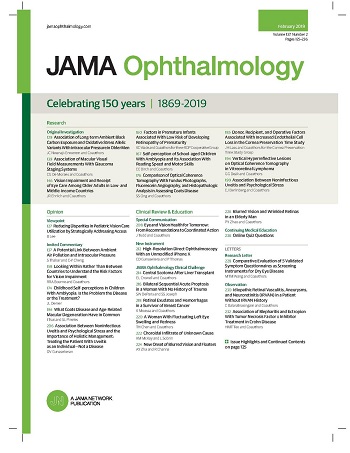Donor Diabetes and 1-Year Descemet Membrane Endothelial Keratoplasty Success Rate: A Randomized Clinical Trial.
IF 9.2
1区 医学
Q1 OPHTHALMOLOGY
引用次数: 0
Abstract
Importance If the success of Descemet membrane endothelial keratoplasty (DMEK) is not affected by whether the donor has diabetes, then the donor pool should expand. Objective To determine whether the 1-year DMEK success rate is affected by the presence of diabetes in the donor. Design, Setting, and Participants This was a multicenter, double-masked, randomized clinical trial conducted from February 2022 to July 2025 at 28 clinical sites (46 surgeons), with donor corneas provided by 13 eye banks in the US. Included in the study were individuals undergoing low to moderate risk DMEK (95% for Fuchs endothelial corneal dystrophy). Study data were analyzed from April to September 2025. Intervention DMEK performed with a cornea from a donor without or with diabetes, assigned using a minimization procedure (comparable with randomization) to achieve an approximate 2:1 distribution, respectively. Main Outcomes and Measures Graft success at 1 year. Results A total of 1097 individuals (1421 study eyes; median [IQR] age, 71 [66-76] years; 631 female [57.5%]) were included in the study. The 1-year cumulative probability of graft success was 96.3% (95% CI, 95.0%-97.5%) among 912 study eyes (64.2%) receiving tissue from donors without diabetes and 97.1% (95% CI, 95.5%-98.4%) among 509 study eyes (35.8%) receiving tissue from donors with diabetes (difference between groups = 0.7 percentage points; 95% CI, -1.2 to 2.6; P = .63). The 1-year cumulative probability of graft success was 96.5% (95% CI, 93.6%-98.9%) in the mild donor diabetes severity subgroup (n = 173) and 97.3% (95% CI, 95.4%-98.8%) in the moderate to severe donor diabetes severity subgroup (n = 336), using a diabetes severity rating scale based on medical history. The rates of primary donor failure, early failure related to surgical complications, and subsequent failure were as follows: 2.5% (23 of 912), 0.7% (6 of 912), and 0.3% (3 of 912), respectively, in recipients of tissue from a donor without diabetes, and 2.6% (13 of 509), 0.4% (2 of 509), and 0%, respectively, among recipients of tissue from a donor with diabetes. There were no failures due to graft rejection. Conclusions and Relevance The 1-year success rate in eyes undergoing DMEK with successfully prepared tissue was very high regardless of donor diabetes status. These results, supported by the separately reported finding that endothelial cell loss and cornea morphometry after 1 year were not affected by donor diabetes status, provide strong support for having no restrictions on the use of tissue from donors with diabetes for DMEK. Trial Registration ClinicalTrials.gov Identifier: NCT05134480.供体糖尿病和1年角膜内皮成形术的成功率:一项随机临床试验。
如果角膜内皮成形术(DMEK)的成功与否不受供体是否患有糖尿病的影响,那么应该扩大供体池。目的探讨供体是否患有糖尿病对1年DMEK手术成功率的影响。设计、环境和参与者这是一项多中心、双盲、随机临床试验,于2022年2月至2025年7月在28个临床地点(46名外科医生)进行,眼角膜由美国13个眼库提供。该研究包括患有低至中等风险DMEK的个体(95%为Fuchs内皮性角膜营养不良)。研究数据分析时间为2025年4月至9月。干预mek对无糖尿病或患有糖尿病的供体角膜进行,采用最小化程序(与随机化相当)分配,分别达到近似2:1的分布。主要观察结果和测量方法:1年移植成功。结果共纳入1097例(1421只研究眼,中位[IQR]年龄71[66 ~ 76]岁,女性631例(57.5%))。在912只接受非糖尿病供者组织的研究眼(64.2%)中,移植成功的1年累积概率为96.3% (95% CI, 95.0%-97.5%),在509只接受糖尿病供者组织的研究眼(35.8%)中,移植成功的累积概率为97.1% (95% CI, 95.5%-98.4%)(组间差异= 0.7个百分点;95% CI, -1.2 - 2.6; P = 0.63)。采用基于病史的糖尿病严重程度评定量表,轻度供体糖尿病严重程度亚组(n = 173) 1年累计移植成功概率为96.5% (95% CI, 93.6%-98.9%),中度至重度供体糖尿病严重程度亚组(n = 336) 1年累计移植成功概率为97.3% (95% CI, 95.4%-98.8%)。原发供体失败、与手术并发症相关的早期失败和随后失败的比率如下:无糖尿病供体的组织受体分别为2.5%(912例中23例)、0.7%(912例中6例)和0.3%(912例中3例),糖尿病供体的组织受体分别为2.6%(509例中13例)、0.4%(509例中2例)和0%。没有一例因移植排斥反应而失败。结论与相关性无论供体是否患有糖尿病,成功制备组织的DMEK 1年的成功率都很高。另外一项研究发现,1年后内皮细胞损失和角膜形态测量不受供体糖尿病状况的影响,这些结果为不限制使用糖尿病供体组织进行DMEK提供了强有力的支持。临床试验注册号:NCT05134480。
本文章由计算机程序翻译,如有差异,请以英文原文为准。
求助全文
约1分钟内获得全文
求助全文
来源期刊

JAMA ophthalmology
OPHTHALMOLOGY-
CiteScore
13.20
自引率
3.70%
发文量
340
期刊介绍:
JAMA Ophthalmology, with a rich history of continuous publication since 1869, stands as a distinguished international, peer-reviewed journal dedicated to ophthalmology and visual science. In 2019, the journal proudly commemorated 150 years of uninterrupted service to the field. As a member of the esteemed JAMA Network, a consortium renowned for its peer-reviewed general medical and specialty publications, JAMA Ophthalmology upholds the highest standards of excellence in disseminating cutting-edge research and insights. Join us in celebrating our legacy and advancing the frontiers of ophthalmology and visual science.
 求助内容:
求助内容: 应助结果提醒方式:
应助结果提醒方式:


